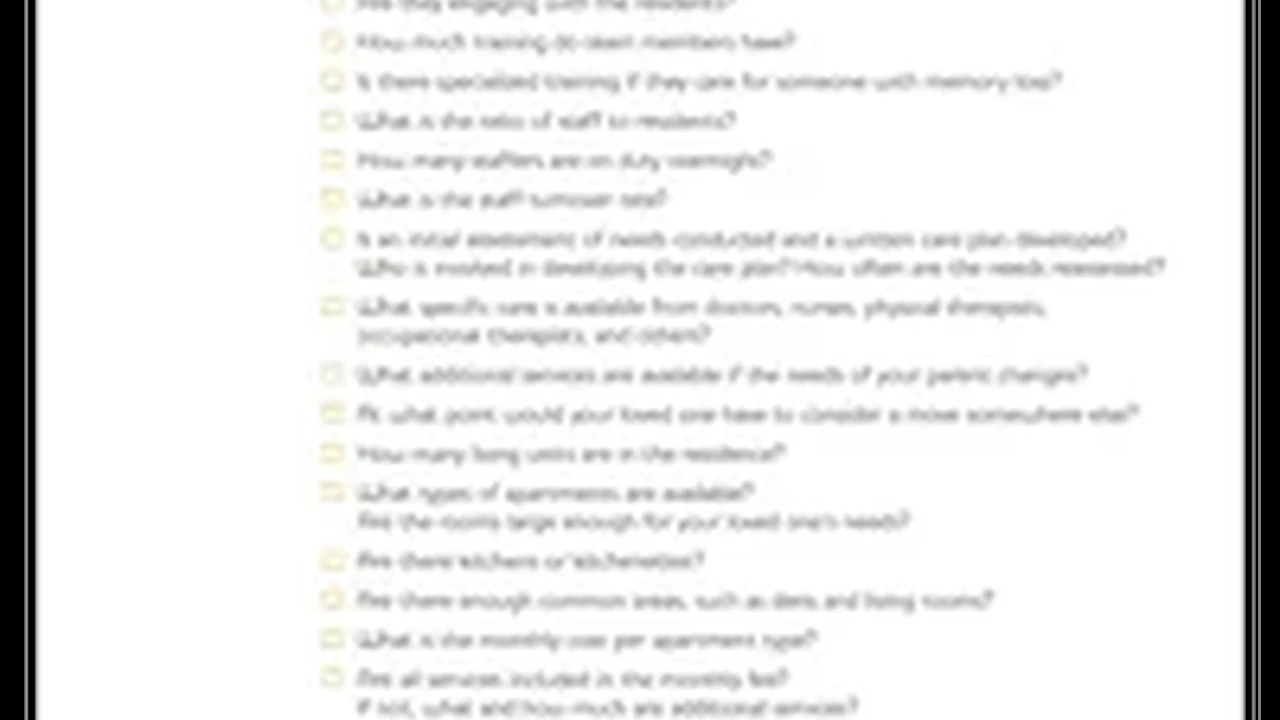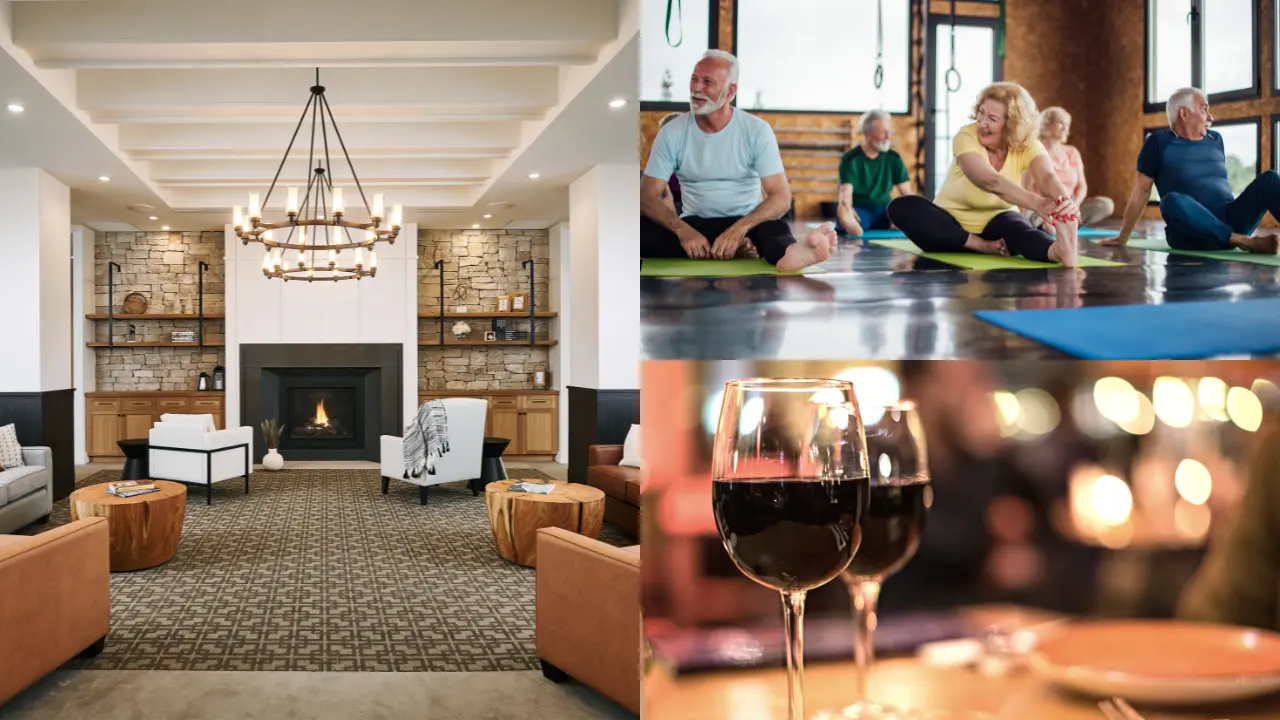5 Questions to Ask Assisted Living Staff
Prepare for your assisted living tours with these crucial questions to ensure you gather all necessary information.

Prepare for your assisted living tours with these crucial questions to ensure you gather all necessary information.
5 Questions to Ask Assisted Living Staff
Navigating the world of assisted living can feel overwhelming, right? You're looking for a place that feels like home, offers top-notch care, and fits your budget. It's a big decision, and you want to get it right. That's why touring facilities and asking the right questions is absolutely essential. Think of it like buying a car – you wouldn't just drive off the lot without checking under the hood, would you? The same goes for choosing an assisted living community. You need to dig deep, ask the tough questions, and really understand what you're getting into. This isn't just about finding a bed; it's about finding a vibrant, supportive community where your loved one can thrive. So, let's arm you with the five most crucial questions to ask assisted living staff during your visits. These aren't just surface-level inquiries; they're designed to uncover the true heart of a community, its commitment to care, and its ability to meet the unique needs of its residents. We'll also dive into some specific products and services that can enhance the assisted living experience, comparing options and even looking at pricing, because let's be real, budget is always a factor.
Question 1 What is the Staff to Resident Ratio and Staff Training for Assisted Living Caregivers
This is probably one of the most important questions you can ask. The staff-to-resident ratio directly impacts the level of attention and care your loved one will receive. A lower ratio generally means more personalized care. Imagine a busy restaurant: if there are too many tables for one server, service quality drops, right? It's similar here. You want to know that when your loved one needs assistance, someone is readily available and not stretched too thin. Don't just accept a general number; ask for specifics. What is the ratio during the day? What about at night? Are there different ratios for different levels of care? For instance, a resident needing extensive personal care might require more frequent assistance than someone who is mostly independent.
Beyond the numbers, delve into staff training. What kind of training do their caregivers receive? Is it ongoing? Do they have specialized training for conditions like dementia or Alzheimer's, even if it's not a dedicated memory care unit? Many assisted living facilities will have residents with varying degrees of cognitive decline, and it's crucial that staff are equipped to handle those needs with patience and expertise. Ask about their turnover rate too. A high turnover rate can be a red flag, indicating potential issues with staff morale, training, or workload. Consistent caregivers mean familiar faces, which is incredibly comforting for residents and helps build trust. For example, some facilities might boast a low staff-to-resident ratio but then reveal that many of their staff are new hires with minimal experience. You want experienced, well-trained, and consistent staff. Look for certifications, ongoing education programs, and a clear commitment to professional development. Some facilities even partner with local colleges or healthcare institutions for advanced training, which is a huge plus.
Question 2 What is the Assisted Living Community's Approach to Personalized Care Plans and Resident Engagement
Every individual is unique, and their care plan should reflect that. A one-size-fits-all approach simply doesn't work in assisted living. Ask how they develop personalized care plans. Is it a collaborative process involving the resident, their family, and medical professionals? How often are these plans reviewed and updated? As needs change, the care plan should adapt accordingly. You want to ensure there's flexibility and a proactive approach to evolving care requirements. For example, if your loved one's mobility decreases, how quickly can their care plan be adjusted to include more assistance with transfers or mobility aids?
Beyond basic care, inquire about resident engagement and activities. What kind of activities do they offer? Are they varied and cater to different interests and abilities? A vibrant activity calendar is a strong indicator of a community that values its residents' well-being and mental stimulation. Ask to see a sample activity schedule. Look for things like exercise classes, social gatherings, educational programs, outings, and creative arts. Are residents encouraged to participate, or are they just left to their own devices? Some communities use technology to enhance engagement. For instance, It's Never Too Late (INTL) offers interactive systems with games, brain exercises, and virtual travel experiences. These can be fantastic for keeping residents mentally active and connected. Another great example is Sagely, which provides a platform for communities to manage activities, communicate with families, and track resident engagement. These types of platforms can significantly improve the quality of life and transparency for families. The cost for such platforms is usually integrated into the monthly fees, but it's worth asking if they utilize any specific engagement technologies. Some communities might even offer personalized tablets pre-loaded with games and communication tools, which could range from $100-$300 for the device itself, plus potential monthly subscription fees if not included in the community's package.
Question 3 What are the Assisted Living Costs and What is Included in the Monthly Fee
Let's talk money, because it's a significant factor for most families. Assisted living costs can vary widely, and it's crucial to understand exactly what's included in the monthly fee and what might incur additional charges. Don't be shy about asking for a detailed breakdown. What services are covered? This typically includes things like meals, basic personal care, housekeeping, laundry, and access to common areas and activities. But what about medication management? Transportation to appointments? Assistance with bathing or dressing beyond a certain level? These are often add-on services that can significantly increase the monthly bill.
Ask about different levels of care and how they impact pricing. Many facilities operate on a tiered system, where higher levels of care (requiring more staff assistance) come with a higher price tag. Get a clear understanding of how they assess care levels and how often these assessments are done. Are there any one-time fees, like an admission fee or community fee? These can sometimes be substantial. Also, inquire about potential price increases. How often do they raise their rates, and by how much? Understanding the financial structure upfront will help you budget effectively and avoid any unpleasant surprises down the road. For example, some communities might offer an all-inclusive rate, which can be simpler to manage, while others have a base rate plus a la carte services. Be sure to compare these models carefully. Some facilities might also have partnerships with financial advisors who can help families navigate payment options, including long-term care insurance, VA benefits, or even reverse mortgages. It's worth exploring these resources if available.
Question 4 How Does the Assisted Living Community Handle Medical Emergencies and Health Monitoring
Safety and health are paramount. You need to feel confident that the community is well-prepared to handle any medical situation that arises. Ask about their emergency protocols. What happens if a resident falls? How quickly do they respond to medical emergencies? Do they have nurses on staff 24/7, or are they on-call? What is their relationship with local hospitals and emergency services? You want to know that there's a clear, efficient plan in place.
Beyond emergencies, inquire about their routine health monitoring. How do they track residents' health? Do they assist with medication management, and if so, what is their system for ensuring accuracy and timeliness? Many facilities use electronic medication administration records (eMAR) systems to minimize errors. For example, PointClickCare and MatrixCare are popular software solutions used in many assisted living facilities for managing resident health records, medications, and care plans. These systems can significantly improve efficiency and accuracy. Ask if they use such technology and how it benefits residents. Also, what is their policy on physician visits? Do they have visiting physicians or specialists, or do residents need to arrange their own transportation to appointments? Some communities even offer telehealth services, which can be incredibly convenient for routine check-ups or minor ailments. Products like GrandCare Systems offer remote monitoring and telehealth capabilities, allowing families and caregivers to keep an eye on vital signs and activity levels. These systems can range from $500-$2000 for initial setup and equipment, plus monthly monitoring fees of $50-$150, depending on the features. While these might not be directly charged to the resident, understanding the technology they employ for health monitoring is crucial.
Question 5 What is the Assisted Living Community's Policy on Family Involvement and Communication
Maintaining strong family connections is vital for a resident's well-being. Ask about their policies regarding family visits. Are there specific visiting hours, or is it more open? How do they communicate with families about a resident's health, well-being, and any changes in their condition? You want a community that fosters open and transparent communication. Do they have regular family meetings or support groups? How do they handle concerns or complaints from family members?
Many modern assisted living communities utilize technology to enhance family communication. For instance, some facilities use secure online portals or apps where families can view activity schedules, care notes, and even communicate directly with staff. Platforms like Caremerge or K4Connect offer features like family portals, messaging, and photo sharing, keeping loved ones connected and informed. These tools can be incredibly reassuring, especially for families who live far away. The cost for these platforms is typically absorbed by the facility, but it's worth asking if they offer such a service. Also, inquire about their approach to resident feedback. Do they have a resident council or a formal process for residents to voice their opinions and suggestions? A community that actively seeks and responds to feedback is usually one that is committed to continuous improvement and resident satisfaction. Ultimately, you're looking for a partnership – a community that sees families as an integral part of the care team, not just visitors.
Choosing an assisted living community is a deeply personal journey, filled with emotional and practical considerations. By asking these five crucial questions, you'll be well-equipped to gather the information you need to make an informed decision. Remember, you're not just looking for a facility; you're looking for a home, a community where your loved one can feel safe, cared for, and engaged. Don't hesitate to ask follow-up questions, observe the interactions between staff and residents, and trust your gut feeling. A good assisted living community will welcome your questions and transparency, understanding that you're seeking the very best for your family member. Happy touring!
:max_bytes(150000):strip_icc()/277019-baked-pork-chops-with-cream-of-mushroom-soup-DDMFS-beauty-4x3-BG-7505-5762b731cf30447d9cbbbbbf387beafa.jpg)





